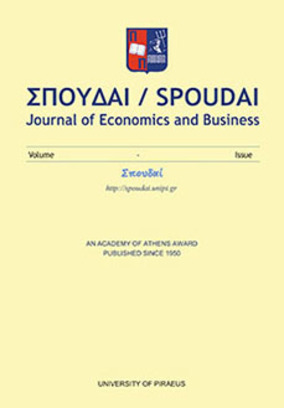The interpretative ability of coefficient R2 to calculate the firm value
Part of : Σπουδαί : journal of economics and business ; Vol.64, No.1, 2014, pages 29-41
Issue:
Pages:
29-41
Author:
Abstract:
Several studies have focused on the relationship between the R 2 and the firm value. They have tried to explain how different values of R2 affect the firm value. In this paper we examine this relationship for the Greek companies listed on the Greek Stock Exchange, analyzing a sample of 135 listed companies for the 2004-2010 period. The results reveal that R2 is inversely related to the firm value. This is consistent with the model of Dow and Gorton (1997). Moreover, we found that companies with high R2 have significantly higher returns than those with low R2, over a two year period time, which is inconsistent with the findings of Stowe and Xing (2011). Moreover, this research shows that the investment decisions are likely to be based more on investor psychology rather than an analysis of firm-specific information.
Subject (LC):
Keywords:
R 2, firm value, Tobin’s Q, long run performance
Notes:
Περιέχει πίνακες και βιβλιογραφία
References (1):
- Amihud, Y., 2002. Liquidity and stock returns: cross – section and time – series effects,Journal of Finance Markets 5, 31-56.Chalkias, I., 2003. Statistical Methods for Business Decisions. Rossili.Chan, K., Hameed, A. and Kang, W., 2012. Stock price synchronicity and liquidity, 4thAnnual Central Bank Workshop on the Microstructure of Financial Markets Hong Kong.Chen, Q., Goldstein, I. and Jiang, W., 2007. Price informativeness and investment sensitivityto stock price, Review of Financial Studies 20, 619-650.Dow, J. and Gorton, G., 1997. Stock market efficiency and economic efficiency: Is there aconnection?, Journal of Finance 52, 1087-1129Fama, E. and Macbeth, J., 1973. Risk, Return, and Equilibrium: Empirical Test, Journal ofPolitical Economy 81, 607-636.Haigh, M., and List, J., 2005. Do professional traders exhibit myopic loss aversion? Anexperimental analysis, Journal of Finance 60, 523-534.Jeffrey, J., 1987. Business Forecasting Methods. Basil Blackwell Ltd.Jensen, W. C., and Meckling W.: “Theory of the firm: Managerial behavior, agency costs andownership structure”, Journal of Financial Economics 3, 1976.Jin, L. and Myers, S., 2006. R2 Around the world: New theory and new tests, Journal ofFinancial Economics 29, 257-292.Lang, L. and Stulz, R., 1994. Tobin’s Q, corporate diversification, and firm performance,Journal of Political Economy 102, 1248-1280.Loderer, C., Neusser, K. and Waelchli, U., 2010. Firm Age and Survival, European WinterFinance Conference in Klosters.Peterson, M., 2009. Estimating Standard Errors in Finance Panel Data Sets: ComparingApproaches, Review of Financial Studies 22, 435-480.Piotroski, J. and Roulstone, D., 2004. The influence of analysts, institutional investors andinsiders on the incorporation of market, industry and firm specific information into stockprices, The Accounting Review 79, 1119-51.Siriopoulos, C. and Philippas, D., 2010. Econometric Models and Applications with Eviews.Anikoula.Stowe, J. and Xing, X., 2011. R2: Does it matter for firm valuation?, The financial Review 46,233-250.Teoh, S., Yang, Y. and Zhang, Y., 2007. R-square: Noise or firm specific information?Working Paper, University of California and Chinese University of Hong Kong.




